
If you have (or are thinking of getting) an inground pool, you’ve undoubtedly had to deal with stuff falling in the water.
Long-time pool owners know that the installation of a swimming pool is only the first step — every year, you’ll need to clean and maintain your pool and its many mechanical and chemical components, to ensure you can keep swimming in clean, healthy, comfortable water.
If you don’t have a pool cover, cleaning and maintenance can quickly become a major chore. Leaves will fall in the pool. Animals might lose their footing or otherwise be drawn by the allure of your pool’s sparkling water. Storms can wreak havoc on your pool’s delicate chemical balances. And that’s just the start...
You’ve got several options when it comes to solving the ongoing problem of detritus and unwanted contaminants falling into your pool.
Some pool owners buy automatic pool robots or hire professional pool maintenance services. Other owners rigorously maintain their pools on their own, testing chemicals and scooping out gunk on a regular basis.
But for many pool owners, a simpler solution is to install an automatic sliding deck pool cover.
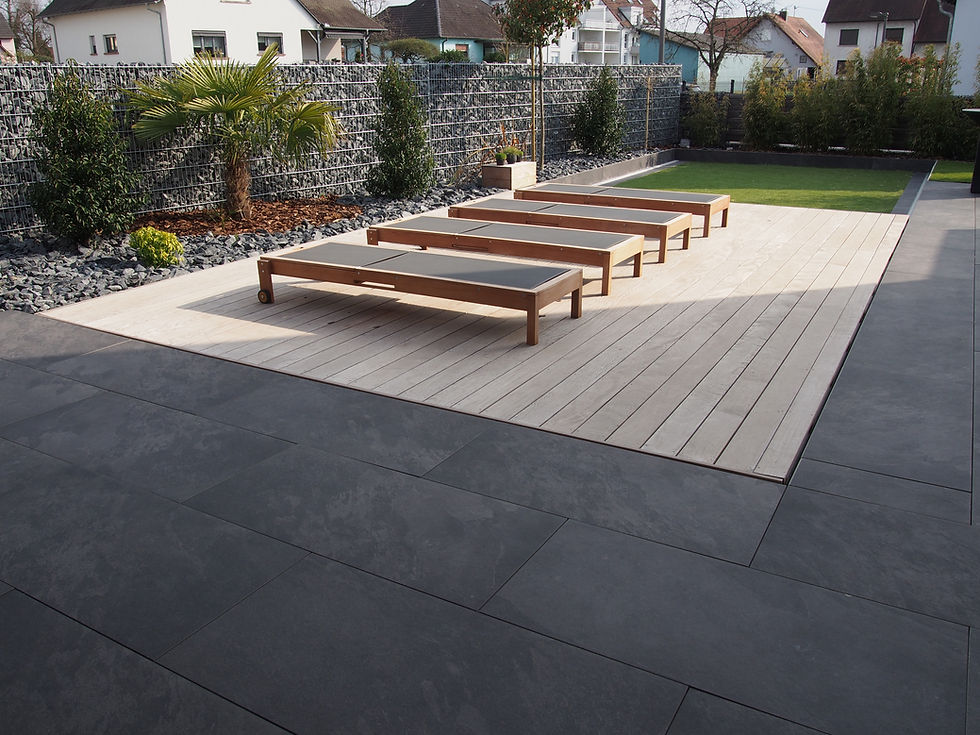
Standard pool covers can be a hassle to put in place, which tends to relegate them to off-season protection duty.
An automatic cover solves this problem by simplifying the process of covering your pool. Instead of manually anchoring your pool cover in place (a process that can take hours), you can simply press a button to extend a sleek, modern, and hands-free sliding deck pool cover over the top of your pool.
You’re probably wondering why you’d opt for a sliding deck pool cover over the usual tarp or mesh covers you’d use in the off-season.
Make no mistake — sliding deck pool covers can be significantly more expensive than standard pool covers. But quality isn’t cheap, and the best sliding deck pool covers not only simplify your pool maintenance, they can also beautify your backyard.
Top-quality sliding pool decks can also allow your pool to pull double duty in your yard by providing a hard, stable surface on which you can entertain guests, host dinner parties, or even have dance parties.
Let’s talk more about what sliding deck pool covers actually are, and how to distinguish them from other types of pool covers.
What is a sliding deck pool cover?
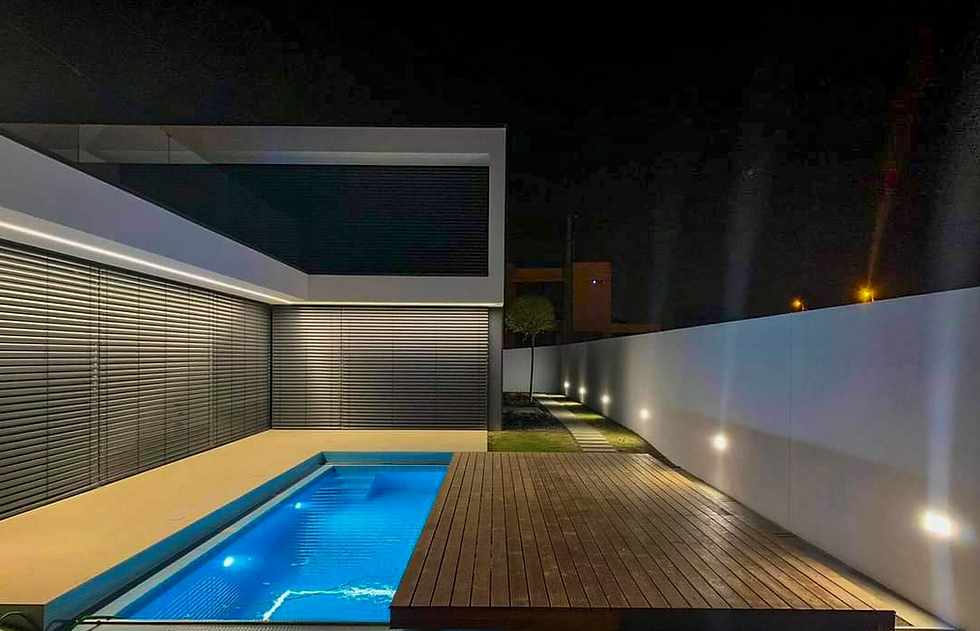
Sliding pool deck covers are typically solid structures that can serve as a barrier between your pool’s water and the outside environment.
Unlike other types of pool covers, sliding decks, as their name may suggest, are often made of wood or composite materials made to resemble wood, and when fully extended, they can resemble backyard decks at or near ground level.
Because sliding pool deck covers are built to resemble decks, they share some important features with your traditional backyard deck — they can hold a reasonable amount of weight, and can often serve as a place to stage outdoor furniture to entertain guests.
How do sliding deck pool covers work?
The weight and complexity of sliding deck pool covers often makes mechanical operation necessary. Most sliding decks use electric or hydraulic motors to open and close over your pool — our R3tract covers utilize one of these two types of motors, depending on the model you choose.
Motorized sliding decks are fairly complex mechanical contraptions, and the best covers are built with ease of use and safety in mind.
Many models are operated with a remote, and some even come with companion mobile apps. Not only does this make operation as easy as pushing a button, it can also prevent accidental activation by children or pets.
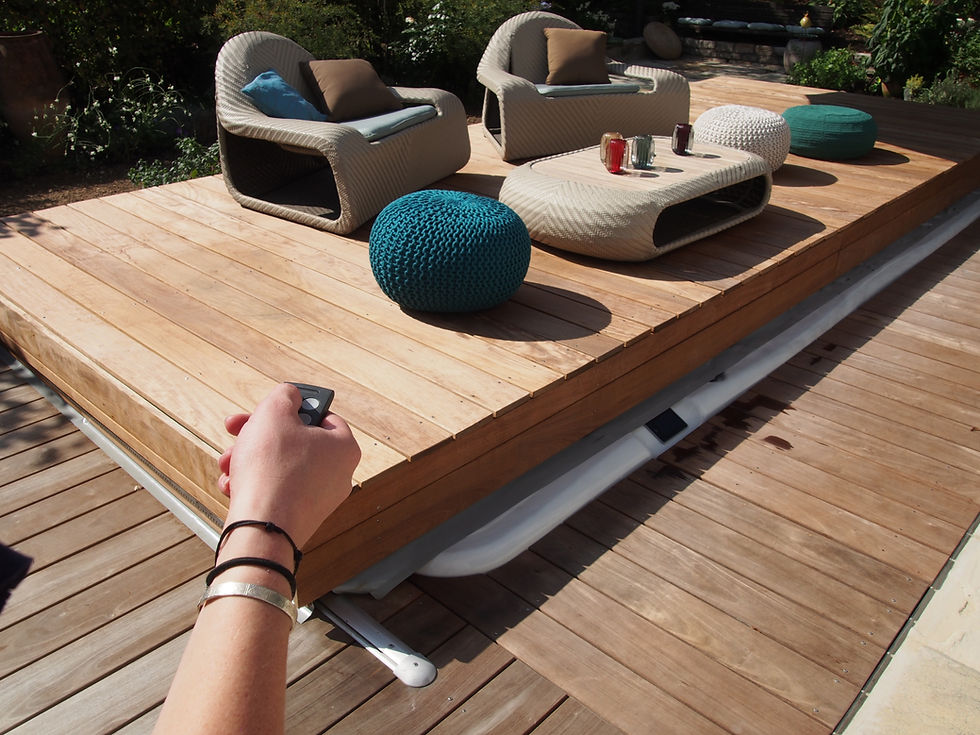
Many sliding deck covers operate on tracks, allowing the system to roll out over the pool or back into a stored position in a smooth motion. Some sliding decks are trackless, but this can actually be more complex than tracked sliding deck covers.
Some sliding decks can retract into recessions built into the side of your pool, while others may fold together like books or accordions to sit above one side of your pool when they’re not covering it.
Some sliding deck models are manually operated, which means you’ll have to pull them over the pool with your own strength when you want to cover the water, and you’ll need to push it out of the way as well when it’s time to take a dip. Manual sliding decks may weigh quite a few pounds, but they’re designed for easy operation — if you can wheel a barbecue around your backyard, you can move a manual sliding deck.
There are a range of different designs and mechanisms used in sliding deck pool covers, and we’ll look at a few different types in the next section of this article.
Make sure you talk to your pool builder and/or your sliding deck provider to make sure you understand how your sliding deck will operate, and how you’ll be able to control it.
You can see a quick video of our H-Line retractable cover in action just below, and if you’d like to see different models and perspectives on our unique sliding deck covers, please check out our YouTube channel.
Some sliding deck pool covers can be operated manually, using the power of your own muscles to slide onto or off of the top of your pool.
What types of sliding deck pool covers are available?
Many pools use “sliding” covers, but this is much different from sliding decks. Most automatic pool covers are made of thin material, run on tracks built into the sides of the pool wall, and are not designed to hold any weight. We’ll discuss these types of pool covers in more detail later in this article, but for now, let’s focus on true sliding decks.
As mentioned above, there are two main types of “sliding” deck pool covers. One type is a true sliding deck. It’s built to resemble an ordinary deck and runs on a track from one end of your pool to the other.
There are many ways to operate a sliding deck pool cover, and many configurations of sliding deck. Let’s look at a few common sliding deck types now...
Above-ground sliding decks
Some sliding decks, as mentioned earlier, are manually operated. This type of sliding deck tends work as a single structure you can move along a low-friction track:
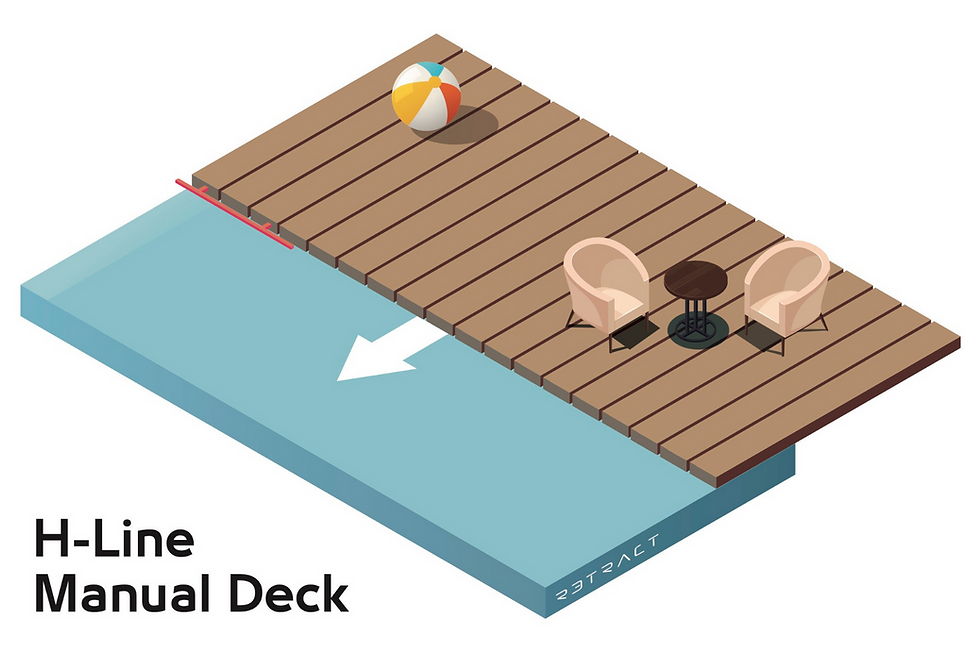 Your sliding deck (whether manual or automatic) can retract into a recessed area for aesthetic purposes, but most sliding decks of this type simply move back and forth atop the pool on their tracks, which minimizes the need to move furniture around when you want to use the space for entertaining. This R3tract H-Line sliding deck is a great example of the type, and is available in either manually-operated or electric modes:
Your sliding deck (whether manual or automatic) can retract into a recessed area for aesthetic purposes, but most sliding decks of this type simply move back and forth atop the pool on their tracks, which minimizes the need to move furniture around when you want to use the space for entertaining. This R3tract H-Line sliding deck is a great example of the type, and is available in either manually-operated or electric modes: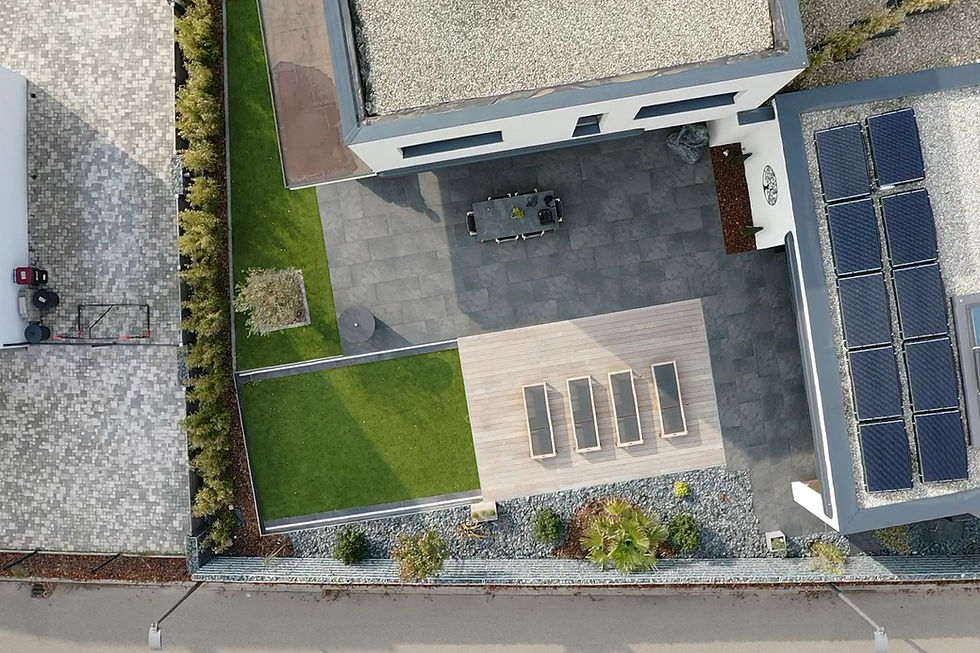
This unibody-style type of sliding deck can move either across the wide edge of your pool or down its narrower edge. You can see both methods of operation in the two pictures above — the illustration shows a widthwise movement, while the live photo of one of our clients’ pools shows a lengthwise movement.
Having the option to slide your deck lengthwise or widthwise ensures that your sliding pool deck cover will work for your backyard space, regardless of the layout of that space.
Seamless (inground) sliding decks
Not all sliding decks are installed above pools. Some can be “seamless,” which means they’ll be built into the pool wall:
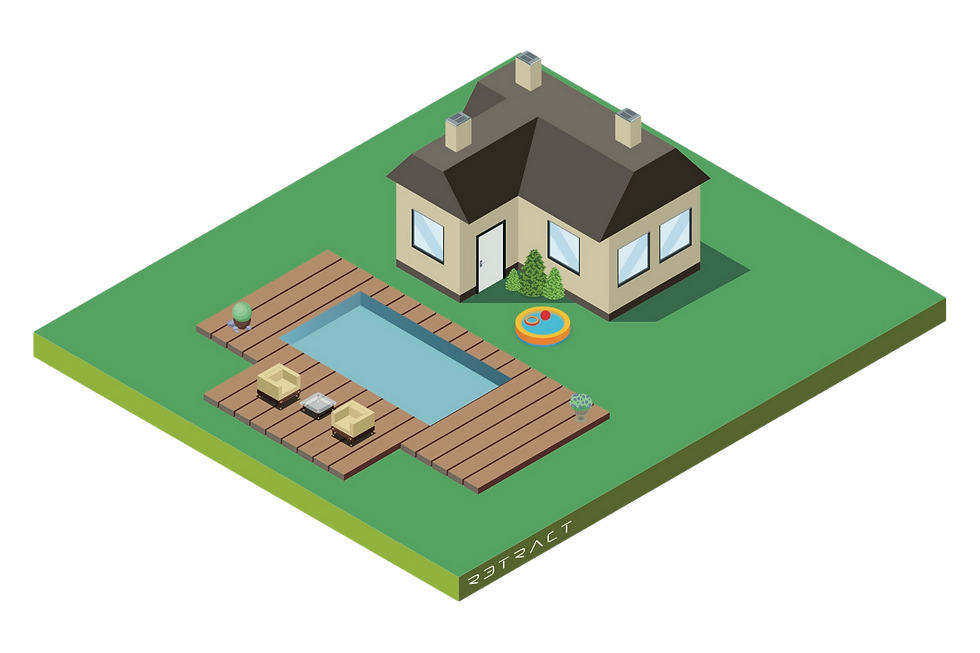
Split sliding decks
Some sliding decks have multiple parts — that is, two (or more) parts of the deck will slide from opposite ends of your pool towards the center. Like unibody-style sliding decks, this type of pool cover can work lengthwise...
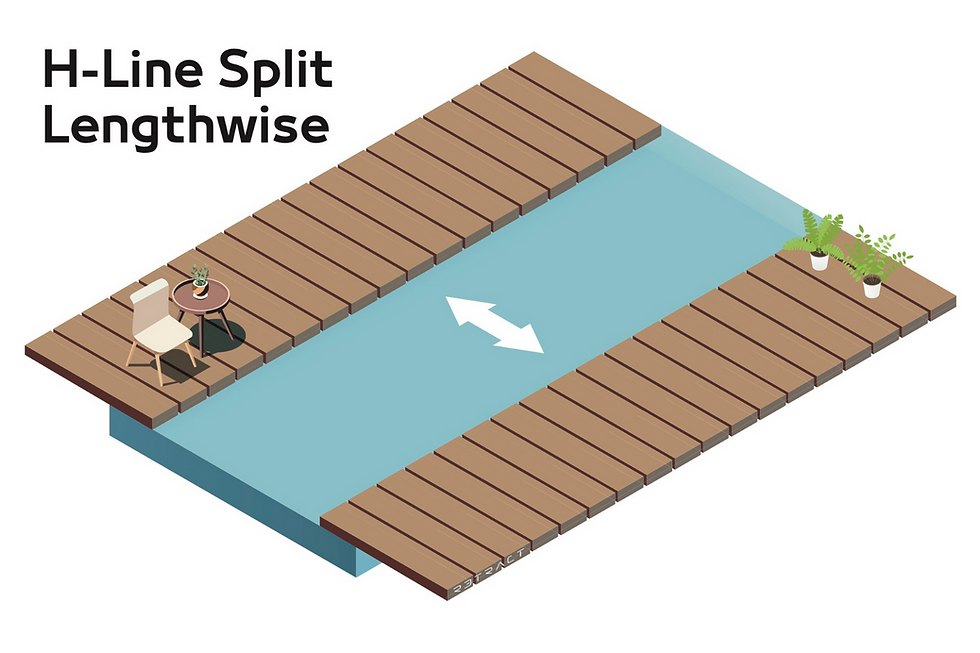 or widthwise:
or widthwise: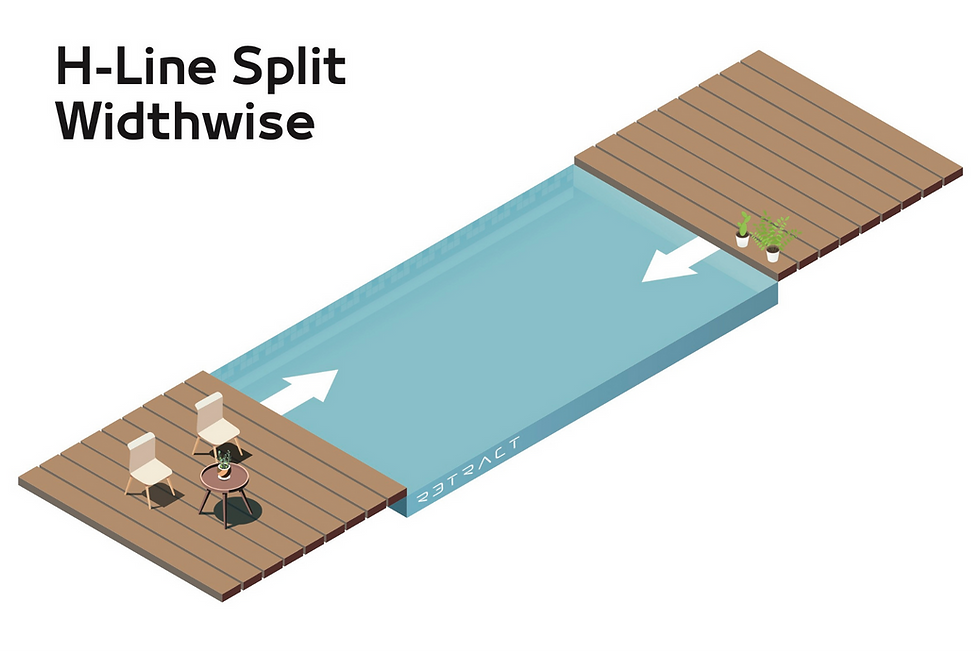
Tucked sliding decks
Some sliding deck pool covers can be set up to slide out from underneath an existing (or newly constructed) static deck. This can be aesthetically pleasing for backyards with existing decking, as the sliding deck can be constructed to match the material and finish of your static deck.
Tucked decks can also extend the deck space in your yard in ways a sliding deck alone might not be able to match. In the picture below, imagine a second deck sliding out from the existing deck to cover the pool surface:
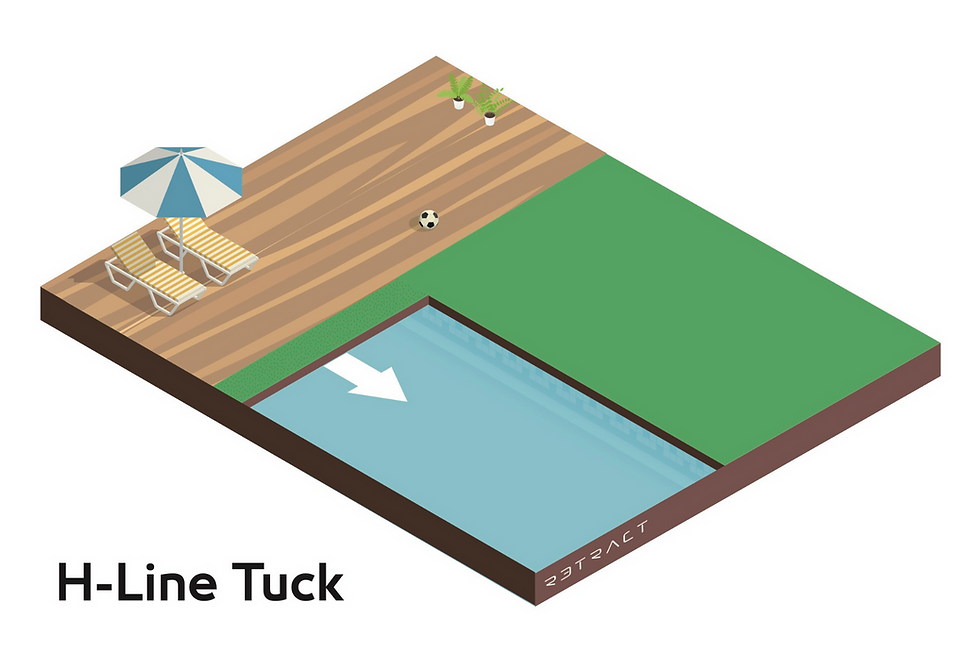
Pretty cool, right?
Telescoping and nesting sliding decks
Sometimes you need more than one (or even two) sliding deck segments. Or maybe you just feel like adding some extra flair to your pool covering. Telescoping sliding decks operate by hydraulically lowering their covering panels, after they’ve moved off the top of exterior deck parts. It looks something like this:
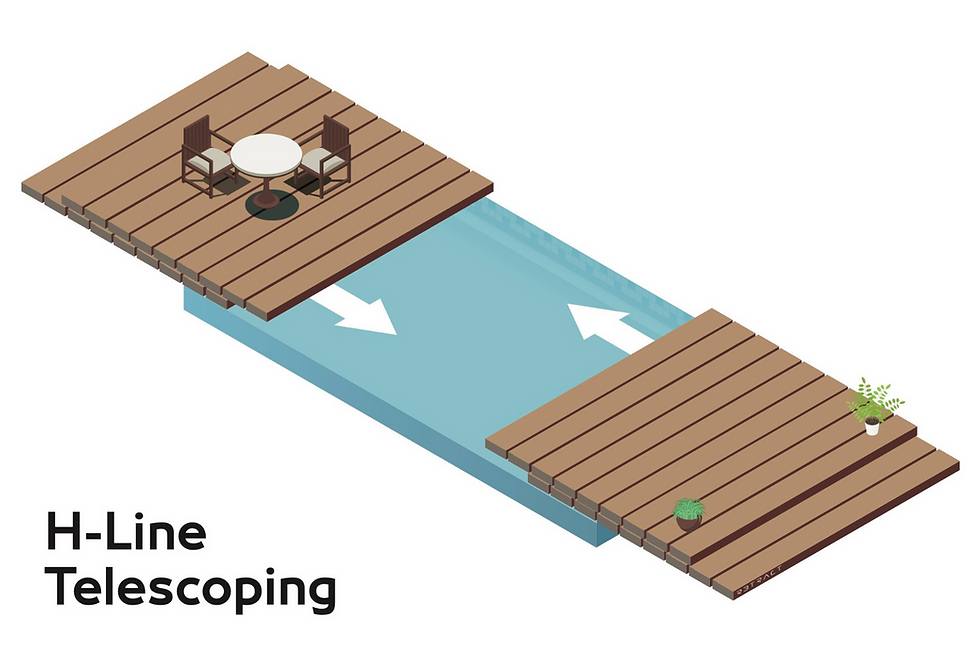
Telescoping sliding deck pool covers have four parts and meet in the center of the pool, similarly to other split sliding decks.
On the other hand, a nested or nesting sliding deck extends from only one side of the pool, with movable parts tucked underneath external decking when not in use:
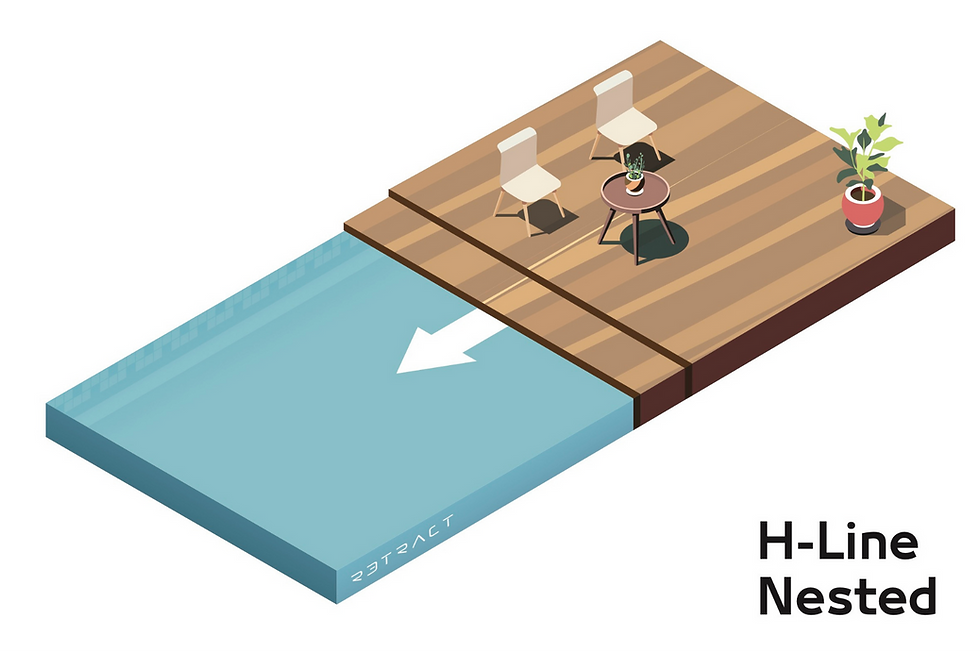
R3tract sliding deck pool covers can operate in a variety of ways — as you can see from the images here, our H-Line model can be installed as a standard sliding deck, in a recessed or seamless configuration, in one or multiple parts, and with manual or electronic operation. If it can slide, it can work as a pool deck covering!
Other types of movable pool decks
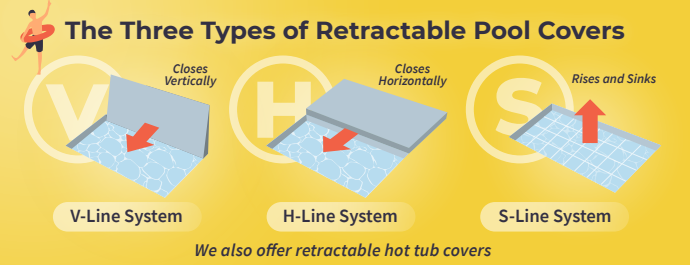
Other movable pool deck coverings can fold up on one side of your pool, resulting in a minimal footprint when not in use.
Such folding pool decks are often great solutions for homes with limited backyard space, since they can look and function somewhat like a wall when folded up and retracted.
You can see a great example of a folding pool deck in a small backyard below, which shows one of our V-Line folding pool decks in its retracted state:
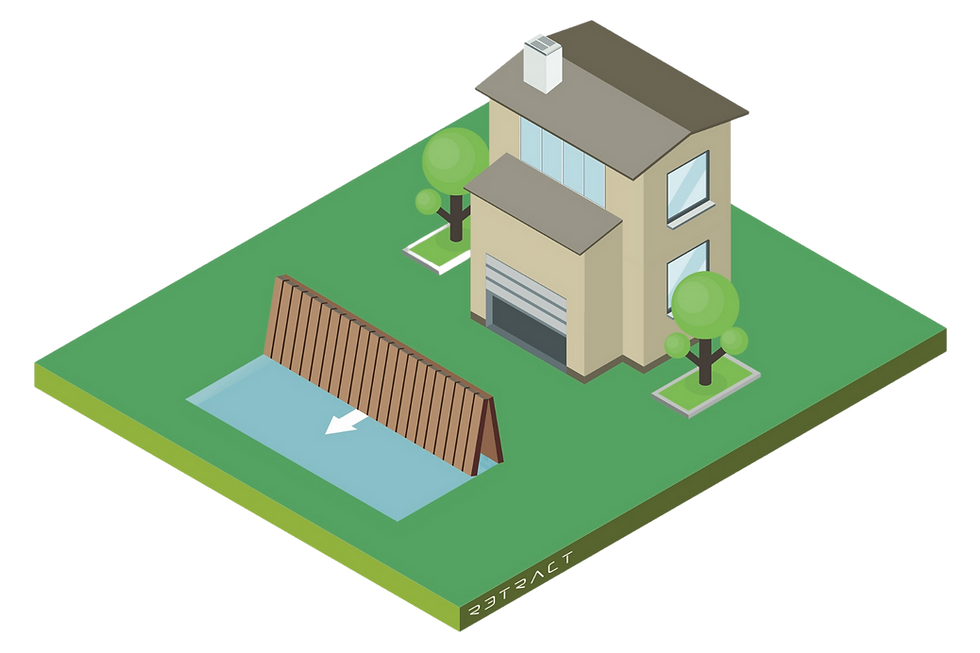
We also produce a moveable floor pool deck, which is installed on the base of the pool and rises to the surface in a (we think) super-cool way:
This type of pool covering isn’t technically a “sliding” deck, but it’s definitely the most space-saving and eye-popping way to protect your pool when it’s not in use.
Are sliding deck pool covers safe?
Sliding deck covers are among the safest types of pool coverings available on the market today. They’re one of the few types of pool covers made to hold weight, and some sliding deck pool covers can hold a lot of weight.
Our pool covers offer similar load-bearing capacity to residential homes.
This means if your living room floor can support it, your R3tract sliding deck pool cover should be able to support it as well. Some of our more well-resourced clients even use their R3tract pool covers as helipads:

You can restrict operational control of a R3tract pool cover with a private smartphone app and/or a coded key. This way, you can be sure the cover won’t move unless you (or someone you trust) tells it to move with the app or key.
You don’t need to be part of the helicopter-owning elite to use a R3tract sliding deck pool cover.
We work with pool owners of all types across North America, whether you’re in downtown Los Angeles or in the middle of Montana — and everywhere else between the two coasts, as well.
Get in touch with us today if you’d like to learn more about R3tract pool covers:
What are the benefits of sliding deck pool covers?
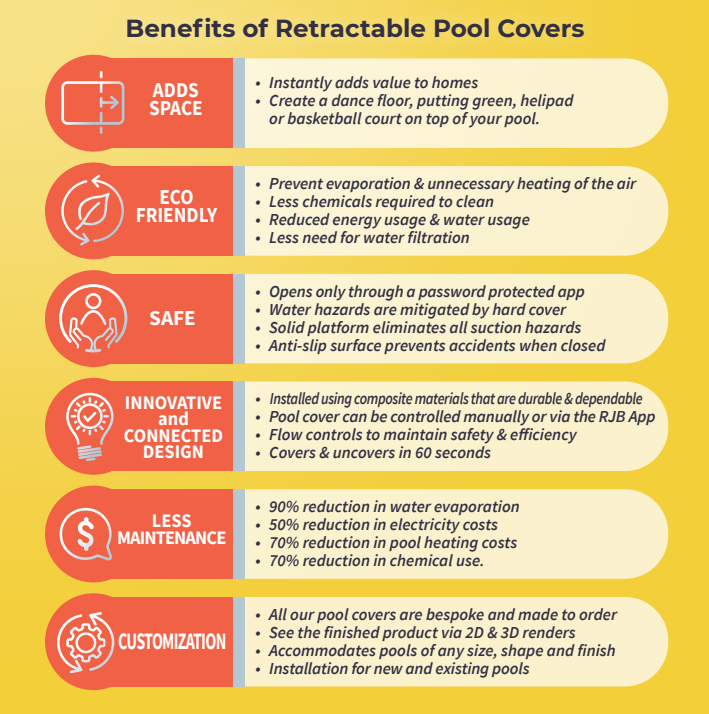
The biggest advantage of using a sliding deck pool cover is often the usable space you’ll gain in your yard. Most parts of the world don’t have pool weather all year round, and a sliding deck can transform your chilly off-season pool into a dining area, party space, or even a dance floor.
Since sliding decks are typically easy to operate, you don’t have to wait for cold weather to use them — you can transform your pool into a covered outdoor entertainment area any time you want.
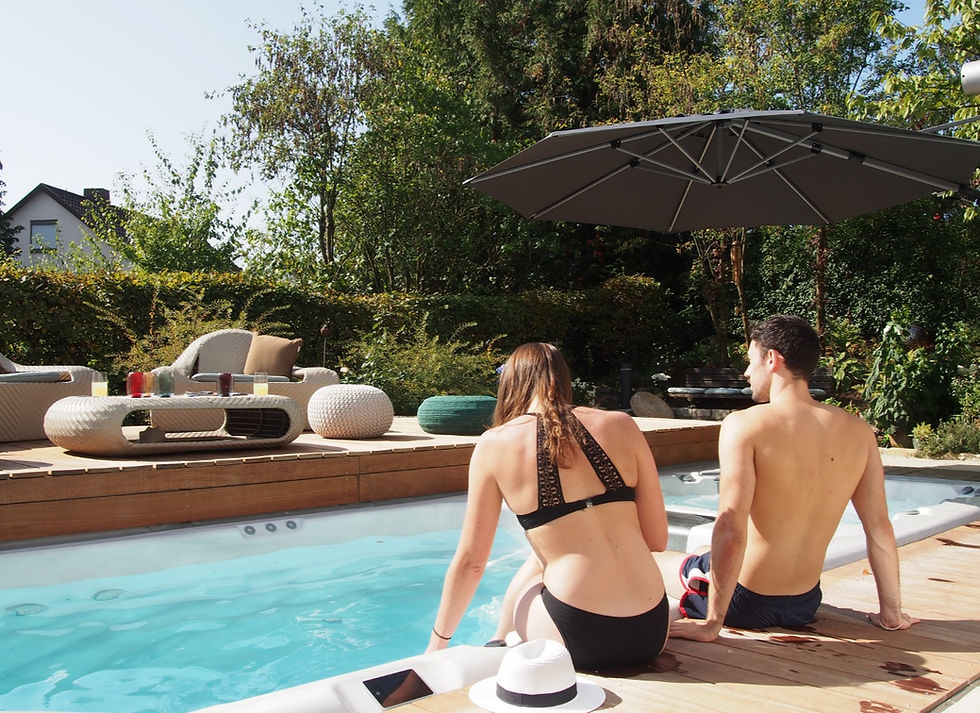
You can also use a sliding deck pool cover to help your pool water retain heat, since it blocks direct sunlight and thus reduces evaporation. R3tract pool covers are insulated to ensure maximum heat retention.
The solid construction of most sliding deck pool covers also makes them a safer and more secure choice of pool covering for families with young children.
Fabric, plastic mesh, or net-based pool covers aren’t designed to support weight, and may pose a risk if a young child were to fall into it. On the other hand, a solid sliding deck over your pool will keep kids (and pets) safe and dry.
Sliding deck pool covers are also among the most attractive and durable pool covers available today. You can get a basic tarp to cover your pool in the off-season, but it’ll look rather basic, and it’s not likely to last through more than a couple of off-seasons.
Many “premium” pool covering options, including flexible vinyl automatic pool covers, will still need to be replaced every few years, often at a cost of several thousand dollars.
A sliding deck pool cover can be as attractive as your best backyard decks, and just as durable. Our sliding deck pool covers are made with some of the same materials as high-end outdoor decks and are designed to last just as long, provided you take care of them the same way you’d care for a backyard deck.
For many homeowners, a sliding deck may be the only pool cover they need, as most people will move to another home before their sliding pool deck ever needs to be replaced or repaired.
What are some drawbacks of sliding deck pool covers?
For most pool owners, the biggest drawback to using a sliding deck pool cover over some other type of cover is its cost. Adding a sliding deck to your pool, either during its construction or some time later, can cost nearly as much as the pool itself.
Sliding deck pool covers aren’t well-suited for all types of pools, either. You can only effectively use a sliding deck with an in ground pool, and it’s best if that pool has a rectangular shape.
Customized pools with unusual shapes or extremely large pools tend to not have the dimensions your sliding deck pool cover would need to effectively cover the entire pool. Because sliding decks tend to be built on rectangular or square frames, they aren’t ideal for any pool with any curved or rounded walls.
These statements are generally true for most sliding deck pool covers. However, R3tract pool covers can be customized to pools of any shape or size, including rounded and irregular shapes. Your only limit is your imagination, and of course, your budget.
If your pool is a reasonably-sized rectangular inground pool, and you have the resources to afford it, a sliding deck pool cover could be a good option for your backyard. These are both big “ifs,” and you’ll also need to consider how you’ll use the space.
A sliding deck may also hinder your ability to use other permanently-installed pool features, such as diving boards, handrails, water features, or any other customized structure right next to your pool.
You may need to choose between that soothing rock waterfall installation your pool builder pitched you and a sliding deck pool cover, unless you’ve found a particularly talented builder with a penchant for integrating multiple automated features into backyard pools.
Since sliding decks are movable, you shouldn’t expect to use any furniture or decor on them permanently — depending on the type of deck you use. This can become a hassle if you plan to use your sliding deck as a regular entertainment space in your yard.
You’ll need extra space for any furniture or decor you plan to use on the deck, either around your pool or in a storage area or shed.
Nested or seamless sliding deck pool covers won’t be able to hold furnishings or decor once they’re tucked out of sight. If you’d rather not move your stuff around every time you open or close your pool, you’re probably better off using a sliding deck that remains flat and visible whether atop the pool or retracted.
What options do you have when choosing a sliding deck pool cover?
Your sliding deck options can vary from manufacturer to manufacturer, and even between different installers in the same area.
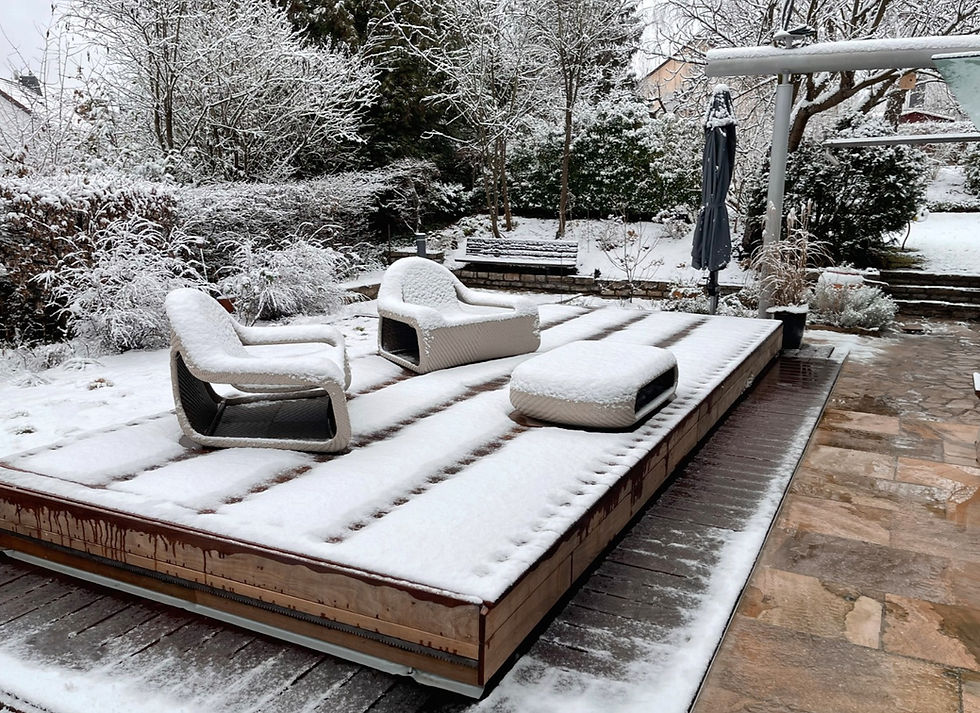
We can’t speak to the options available on other manufacturers’ sliding decks, but R3tract pool decks can be installed with a wide range of options, including many different finishes, colors, and related accessories.

We have over 20 different finishes available for your sliding deck, including:
-
Wood (the standard deck finish)
-
Composite Wood
-
Stone
-
Turf
-
Marble
-
PlexiGlass
You can also have your R3tract sliding deck built to match the finish of your existing backyard space, but you may need to supply matching materials.
Our sliding decks can operate in several ways, which we’ve already mentioned earlier — they slide, retract, fold, or even rise from the floor of your pool.
We can also help you customize the space around your pool and sliding deck with retractable or hidden sound systems, disappearing fire pits, car platforms, and many other moveable, retractable, and hide-able decor options.
What do sliding deck pool covers cost?
Let’s be honest — looking cool doesn’t come cheap.
A sliding deck may be the best-looking, safest, and most durable option for covering your pool, but it’s also likely to be the most expensive. In some cases, your sliding deck might cost as much as (or more than) the pool itself.
Some sliding decks start in the $25,000 range.

Our R3tract pool covers typically start at $50,000. The cost to install a bespoke sliding deck pool cover can quickly rise to $75,000 or even $100,000 or more, depending on the size and shape of your pool, the type of mechanism you want to use, deck materials and finishes, and other factors.
We tend to price our sliding deck pool covers by type (hydraulic or electric), and by size. Here’s a rough guideline to R3tract sliding deck pool cover price ranges:
|
Type of Sliding Deck |
Square Footage |
Sliding Pool Cover Cost |
|
Manual Sliding Deck |
200 sq. ft. |
$25,000 |
|
Electric Sliding Deck |
200 sq. ft |
$35,000 |
|
Hydraulic Sliding Deck |
200 sq. ft. |
$75,000 |
The best way to figure out how much a sliding deck will cost to install on your pool is to contact the pros. Reach out to us for a customized quote based on your unique space requirements and design preferences:
Sliding deck pool covers vs. automatic pool covers
Automatic pool covers, like sliding decks, tend to run on tracks from one end of your pool to the other. Unlike R3tract sliding deck pool covers, automatic pool covers tend to be limited to square or rectangular-shaped pools, since their mechanisms depend on straight lines to operate correctly and cover your pool adequately.
Most automatic pool covers, when installed by a professional, will cost anywhere between $10,000 and $30,000. This is less costly than a sliding deck, but you’ll lose any sort of above-the-pool functionality, as automatic covers aren’t designed to be load-bearing.
Depending on the size of your pool and the type of material you use for your automatic cover, you may also need to get an additional pump to remove rainwater from atop the cover after a storm. These pumps can add another $1,000 or more to the cost of your cover project, but you’ll need them to keep the cover clean and in good condition.
Most automatic covers will need replacement every five years or so.
The automatic mechanism can be used for many years, but you’ll probably spend anywhere from $2,500 to $5,000 or more to replace the cover itself. This cost typically includes professional replacement, which is recommended, as an automatic cover can malfunction or break if installed incorrectly.
Sliding deck pool covers vs. other pool covers
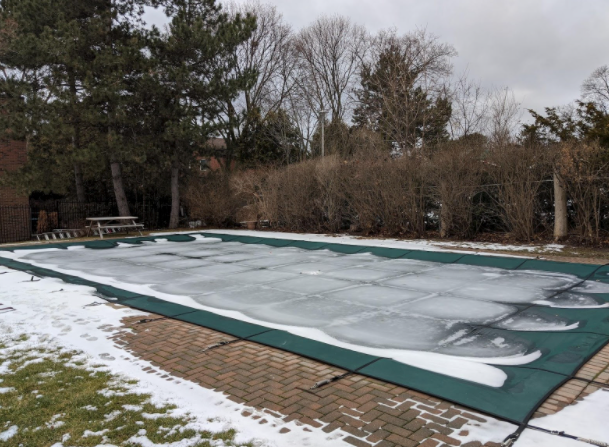
You can get some types of pool covers relatively cheaply.
The least expensive type of pool covering is a simple tarp used during the offseason. You can order many tarp-type pool covers on Amazon or through various pool supply websites.
Many pool owners opt for security covers to protect their pool in the offseason. These covers are similar to tarp-type covers, but they’re designed to anchor around your pool, and are often made with more durable materials than the typical tarp winter cover.
Tarps and security covers are not automatic. You’ll need to secure them in place yourself (or hire a pool pro) when you close your pool down for the winter, and you’ll need to pull it back and store it somewhere safe during swimming season.
Basic tarp covers will usually cost between $100 and $350, depending on the size of your pool and the tarp’s material.
You may also need to get weights to hold the tarp in place — you can use something as basic as a bag of concrete, but if you want to maintain some aesthetic appeal in the offseason, you may wind up spending more on stuff to disguise your weights than you will on the tarp itself.
Because tarp covers are the least expensive option, they’re also generally the least durable option. You shouldn’t expect to get more than two or three years out of a basic tarp cover, and in some climates, you’ll end up replacing the tarp every year.
Security covers can run anywhere from $1,000 to $4,000 or more.
This may or may not include installation of anchor points around the pool perimeter. You’ll need to replace your security cover every few years — most pool owners replace their security covers every 5-10 years.
Is your pool ready for a sliding deck cover?
A sliding deck pool cover can be a beautiful addition to your backyard oasis, but it’s not a project you can expect to tackle on your own.
The only way to know whether or not a sliding deck is the best choice for your pool is to contact a reputable manufacturer, like R3tract.
Our experienced team can guide you through the entire process, from the initial designs and cost estimates to installation and use.
Get in touch with us today to see what R3tract can do for your pool:
